Native vs. Unique Fruit Popularity: Exploring the Sustainable Fruit Consumption in Poland—Research Report
Abstract
1. Introduction
- -
- Consumption of goods and services that meet basic needs and provide a better quality of life;
- -
- Reducing the use of natural resources, toxic materials, waste emissions, and pollutants;
- -
- Making it possible to meet the needs of future generations [29].
2. Materials and Methods
- -
- Non-probability sampling;
- -
- Exponential non-discriminative snowball sampling [44];
- -
- Virtual sampling (digital form);
- -
- Scientific networks (for example ResearchGate or LinkedIn) for sharing the link to the survey;
- -
- Social networks (for example Meta) for sharing the link to the survey.
- -
- Gender;
- -
- Age;
- -
- Educational level;
- -
- Marital status;
- -
- Region and area of residence;
- -
- Number of people in the household;
- -
- Indicative net income.
3. Results
3.1. Research Group Characteristics
3.2. Fruits Supply Sources Characterisation
3.3. The Characteristics of Fruit Consumption Trends
4. Discussion
4.1. The Place of Purchasing Fruit
4.2. The Aspect of the Ecological Quality of the Purchased Fruit
4.3. The Selection of Polish or Foreign Fruit
5. Conclusions
- -
- The publication of texts devoted to sustainable development issues (including organic food facts) that are only in the form of open access;
- -
- The introduction of additional research grants for research related to the presented topic, in which the award criterion is not based mainly on the existing scientific achievements (open to more innovative approaches and new points of view on the issue);
- -
- An increase in the emphasis on education during the first stages of education;
- -
- The introduction of compulsory subjects at each stage of education related to a healthy lifestyle/proper nutrition;
- -
- Further social campaigns (in which the methods of breaking the record are used—repeated information about the same recommendations within various messages), ensuring that the public will have daily contact with sustainable food recommendations;
- -
- The conduction of practical campaigns enabling the costing of organic fruit, joint preparation of meals (learning by doing), and receipt of current feedback from consumers.
Supplementary Materials
Author Contributions
Funding
Institutional Review Board Statement
Informed Consent Statement
Data Availability Statement
Conflicts of Interest
References
- WHO. Diet, Nutrition and the Prevention of Chronic Diseases, Report of a Joint WHO/FAO Expert Consultation; WHO Technical Report Series 916; WHO: Geneva, Switzerland, 2003. [Google Scholar]
- FAO. Promotion of Fruits and Vegetables for Health: Report of the Pacific Regional Workshop; Food and Agriculture Organization of the United Nations: Rome, Italy, 2015. [Google Scholar]
- Xaba, T.; Dlamini, S. Factors associated with consumption of fruits and vegetables amongst adults in the Alfred Duma Local Municipality, Ladysmith. S. Afr. J. Clin. Nutr. 2021, 34, 72–83. [Google Scholar] [CrossRef]
- Polsky, J.Y.; Garriguet, D. Change in vegetable and fruit consumption in Canada between 2004 and 2015. Healths Report. Stat. Can. 2020, 31, 3–12. [Google Scholar] [CrossRef]
- Sidiq, R.; Hasniyati, R.; Handayani, M. Nutrition education and changes in mother’s behavior towards fulfillment of vegetable and fruit consumption strategies in preschool children. AcTion Aceh Nutr. J. 2021, 6, 1–8. [Google Scholar] [CrossRef]
- Harton, A.; Florczak, J.; Myszkowska-Ryciak, J.; Gajewska, D. Fruit and vegetable consumption by preschool children. Probl. Hig. Epidemiol. 2015, 96, 732–736. (In Polish) [Google Scholar]
- Herath, U.S. Fruit consumption, its determinants and attitudes among undergraduates. Int. J. Agric. Environ. Food Sci. 2019, 3, 50–53. [Google Scholar] [CrossRef]
- Desbouys, L.; De Ridder, K.; Rouche, M.; Castetbon, K. Food Consumption in Adolescents and Young Adults: Age-Specific Socio-Economic and Cultural Disparities (Belgian Food Consumption Survey 2014). Nutrients 2019, 11, 1520. [Google Scholar] [CrossRef]
- Sato, Y.; Miyanaga, M.; Wang, D.H. Psychosocial Determinants of Fruit and Vegetable Intake in Japanese Adolescents: A School-Based Study in Japan. Int. J. Environ. Res. Public Health 2020, 17, 5550. [Google Scholar] [CrossRef]
- López-Olivares, M.; Galván, D.T.C.; Nestares, T.; Fernández-Gómez, E.; Enrique-Mirón, C. Lifestyle Factors Influencing Dietary Patterns of University Professors. Int. J. Environ. Res. Public Health 2021, 18, 9777. [Google Scholar] [CrossRef] [PubMed]
- Kanungsukkasem, U.; Ng, N.; Minh, H.V.; Razzaque, A.; Ashraf, A.; Juvekar, S.; Ahmed, S.M.; Bich, T.H. Fruit and vegetable consumption in rural adults population in INDEPTH HDSS sites in Asia. Glob. Health Action 2009, 2, 1988. [Google Scholar] [CrossRef]
- Saxe-Custack, A.; LaChance, J.; Hanna-Attisha, M. Child Consumption of Whole Fruit and Fruit Juice Following Six Months of Exposure to a Pediatric Fruit and Vegetable Prescription Program. Nutrients 2020, 12, 25. [Google Scholar] [CrossRef]
- Hurtado-Barroso, S.; Trius-Soler, M.; Lamuela-Raventós, R.M.; Zamora-Ros, R. Vegetable and Fruit Consumption and Prognosis among Cancer Survivors: A Systematic Review and Meta-Analysis of Cohort Studies. Adv. Nutr. 2020, 11, 1569–1582. [Google Scholar] [CrossRef] [PubMed]
- Cheng, H.-Y.; Shi, Y.-X.; Yu, F.-N.; Zhao, H.-Z.; Zhang, J.-H.; Song, M. Association between vegetables and fruits consumption and depressive symptoms in a middle-aged Chinese population An observational study. Medicine 2019, 98, e15374. [Google Scholar] [CrossRef] [PubMed]
- Dreher, M.L. Whole fruits and fruit fiber emerging health effects. Nutrients 2018, 10, 1833. [Google Scholar] [CrossRef] [PubMed]
- Wallace, T.C.; Bailey, R.L.; Blumberg, J.B.; Burton-Freeman, B.; Chen, O.; Crowe-White, K.M.; Drewnowski, A.; Hooshmand, S.; Johnson, E.; Lewis, R.; et al. Fruits, vegetables, and health: A comprehensive narrative, umbrella review of the science and recommendations for enhanced public policy to improve intake. Crit. Rev. Food Sci. 2020, 60, 2174–2211. [Google Scholar] [CrossRef]
- Djousse’, L.; Arnett, D.K.; Coon, H.; Province, M.A.; Moore, L.L.; Ellison, C.R. Fruit and vegetable consumption and LDL cholesterol: The National Heart, Lung, and Blood Institute Family Heart Study. Am. J. Clin. Nutr. 2004, 79, 213–217. [Google Scholar] [CrossRef]
- He, F.J.; Nowson, C.A.; MacGregor, G.A. Fruit and vegetable consumption and stroke: Meta-analysis of cohort studies. Lancet 2006, 367, 320–326. [Google Scholar] [CrossRef]
- Río-Celestino, M.; Font, R. The Health Benefits of Fruits and Vegetables. Foods 2020, 9, 369. [Google Scholar] [CrossRef]
- Lim, S.S.; Vos, T.; Flaxman, A.D.; Danaei, G.; Shibuya, K.; Adair-Rohani, H.; AlMazroa, M.A.; Amann, M.; Anderson, H.R.; Andrews, K.G.; et al. A comparative risk assessment of burden of disease and injury attributable to 67 risk factors and risk factor clusters in 21 regions, 1990–2010: A systematic analysis for the Global Burden of Disease Study 2010. Lancet 2012, 380, 2224–2260. [Google Scholar] [CrossRef]
- Du, H.D.; Li, L.M.; Bennett, D.; Yang, L.; Guo, Y.; Key, T.J.; Bian, Z.; Chen, Y.P.; Walters, R.G.; Millwood, I.Y.; et al. Fresh fruit consumption and all-cause and cause-specific mortality: Findings from the China Kadoorie Biobank. Int. J. Epidemiol. 2017, 46, 1444–1455. [Google Scholar] [CrossRef] [PubMed]
- Kapusta, F. Fruit market in Poland during the pre-accession period and after the accession to the European Union. Econ. 21st Century 2014, 3, 9–22. (In Polish) [Google Scholar]
- Zupo, R.; Castellana, F.; Sardone, R.; Sila, A.; Giagulli, V.A.; Triggiani, V.; Cincione, R.I.; Giannelli, G.; De Pergola, G. Preliminary Trajectories in Dietary Behaviors during the COVID-19 Pandemic: A Public Health Call to Action to Face Obesity. Int. J. Environ. Res. Public Health 2020, 17, 7073. [Google Scholar] [CrossRef] [PubMed]
- Sidor, A.; Rzymski, P. Dietary Choices and Habits during COVID-19 Lockdown: Experience from Poland. Nutrients 2020, 12, 1657. [Google Scholar] [CrossRef] [PubMed]
- Lallukka, T.; Lahti-Koski, M.; Ovaskainen, M.L. Vegetable and fruit consumption and its determinants in young Finnish adults. Näringsforskning 2001, 45, 120–125. [Google Scholar] [CrossRef]
- Tenelanda-López, D.; Valdivia-Moral, P.; Castro-Sánchez, M. Eating Habits and Their Relationship to Oral Health. Nutrients 2020, 12, 2619. [Google Scholar] [CrossRef]
- Tetens, I.; Alinia, S. The role of fruit consumption in the prevention of obesity. J. Hortic. Sci. Biotechnol. 2009, 84, 47–51. [Google Scholar] [CrossRef]
- Welch, D.; Southerton, D. After Paris: Transitions for sustainable consumption. Sustain. Sci. Pract. Policy 2019, 15, 31–44. [Google Scholar] [CrossRef]
- NmotE. Oslo Roundtable on Sustainable Production and Consumption; Ministry of the Environment: Oslo, Norway, 1994.
- Pocol, C.B.; Marinescu, V.; Amuza, A.; Cadar, R.L.; Rodideal, A.A. Sustainable vs. Unsustainable Food Consumption Behaviour: A Study among Students from Romania, Bulgaria and Moldova. Sustainability 2020, 12, 4699. [Google Scholar] [CrossRef]
- Macieira, A.; Barbosa, J.; Teixeira, P. Food Safety in Local Farming of Fruits and Vegetables. Int. J. Environ. Res. Public Health 2021, 18, 9733. [Google Scholar] [CrossRef]
- Qadri, O.S.; Yousuf, B.; Srivastava, A.K. Fresh-cut fruits and vegetables: Critical factors influencing microbiology and novel approaches to prevent microbial risks—A review. Cogent Food Agric. 2015, 1, 1121606. [Google Scholar] [CrossRef]
- Normann, A.; Röding, M.; Wendin, K. Sustainable Fruit Consumption: The Influence of Color, Shape and Damage on Consumer Sensory Perception and Liking of Different Apples. Sustainability 2019, 11, 4626. [Google Scholar] [CrossRef]
- Appetite for Polish, In the Production of Which Vegetables and Fruit is Poland the Leader on a European and Global Scale? 2020. Available online: https://apetytnapolskie.com/w-produkcji-ktorych-warzyw-i-owocow-polska-jest-potentatem-na-skale-europejska-i-swiatowa/ (accessed on 18 May 2022). (In Polish).
- Doroszko, M.; Janda, K.; Jakubczyk, K. Healthy properties of selected national fruits. Kosmos. Probl. Nauk Biol. 2018, 67, 415–423. (In Polish) [Google Scholar]
- Malczyk, E.; Całyniuk, Z.; Syc, M. Ssessment of the frequency of consumption of fruits and vegetables by students of Medical University of Lublin. Bromat. Chem. Tosykol 2016, 4, 780–787. (In Polish) [Google Scholar]
- GUS. Statistical Yearbook of the Regions—Poland; Statistics Poland: Warsaw, Poland, 2019.
- GUS. Household Budget Survey in 2019; Statistics Poland: Warsaw, Poland, 2020.
- Wróblewska, W.; Chudzik, A. Impact of Fruits’ and Means’ of Production Prices Volatility on Economic Situation of Fruit Producers in Poland. Zesz. Nauk. Szkoły Głównej Gospod. Wiej. Ekon. Organ. Gospod. Żywnościowej 2015, 109, 123–132. (In Polish) [Google Scholar]
- Sobczak, W.; Jabłońska, L.; Olewnicki, D. The Degree of Fruit and Vegetables Growers Self-Organization in Poland. 2013. Available online: http://sj.wne.sggw.pl/pdf/PRS_2013_T13_n1_s119.pdf (accessed on 30 December 2020). (In Polish).
- Resolution No. 9/2022 the Managing Committee of the Fruit and Vegetable Promotion Fund of 8 September 2022 on the Adoption of a Promotion Strategy for the Fruit and Vegetable Industry for 2023. (In Polish). Available online: https://www.google.com/url?sa=i&rct=j&q=&esrc=s&source=web&cd=&cad=rja&uact=8&ved=0CAIQw7AJahcKEwjYq5LmzYiAAxUAAAAAHQAAAAAQAw&url=https%3A%2F%2Fwww.gov.pl%2Fattachment%2F46ffb5ec-431d-4218-8feb-30b51bbe42ef&psig=AOvVaw1OdilAVd7tvtuQKzhghVsI&ust=1689232018571621&opi=89978449 (accessed on 10 March 2023).
- Zmarlicki, K.; Brzozowski, P.; Karmańska, M. Forecast of Changes in the Supply and Production of Fruit in Poland. In Hort Skierniewice; Instytut Ogrodnictwa: Skierniewice, Poland, 2014. (In Polish) [Google Scholar]
- Jąder, K.; Wawrzyniak, J. Changes in the Consumption of Fruits and Vegetables and their Preserves in Poland in 1999–2013 and the Phenomenon of Sustainable Consumption. J. Agribus. Rural. Dev. 2015, 3, 427–435. (In Polish) [Google Scholar] [CrossRef]
- Simkus, J. Snowball Sampling: Definition, Method and Examples 2020. Available online: https://www.simplypsychology.org/snowball-sampling.html (accessed on 24 May 2022).
- Płocharski, W.; Markowski, J.; Nosecka, B.; Pytasz, U.; Rutkowski, K.; Stoś, K. Fruit, vegetables, juices—Their energy and nutritional value compared to the requirement of energy and nutrients. Przem. Ferment. Owoc.-Warz. 2013, 4, 22–29. (In Polish) [Google Scholar]
- Stangierska, D.; Kowalczuk, I.; Widera, K.; Olewnicki, D.; Latocha, P. Innovation as a Factor Increasing Fruit Consumption: The Case of Poland. Nutrients 2022, 14, 1246. [Google Scholar] [CrossRef] [PubMed]
- Stea, T.H.; Nordheim, O.; Bere, E.; Stornes, P.; Eikemo, T.A. Fruit and vegetable consumption in Europe according to gender, educational attainment and regional affiliation—A cross-sectional study in 21 European countries. PLoS ONE 2020, 15, e0232521. [Google Scholar] [CrossRef] [PubMed]
- Romaniuk, P.; Kaczmarek, K.; Brukało, K.; Grochowska-Niedworok, E.; Łobczowska, K.; Banik, A.; Luszczynska, A.; Poelman, M.; Harrington, J.M.; Vandevijvere, S.; et al. The Healthy Food Environment Policy Index in Poland: Implementation Gaps and Actions for Improvement. Foods 2022, 11, 1648. [Google Scholar] [CrossRef] [PubMed]
- Jarczok-Guzy, M. Obstacles to the development of the organic food market in Poland and the possible directions of growth. Food Sci. Nutr. 2018, 6, 1462–1472. [Google Scholar] [CrossRef] [PubMed]
- Chidiebere-Mark, N. Consumers’ Attitude and Behaviour to Fruit Consumption in Owerri Municipal, Imo State, Nigeria. In Proceedings of the Annual International Conference on Business, Marketing and Management, Oxford, UK, 5–7 April 2016. [Google Scholar]
- Bárbara, R.; Ferreira-Pêgo, C. Changes in Eating Habits among Displaced and Non-Displaced University Students. Int. J. Environ. Res. Public Health 2020, 17, 5369. [Google Scholar] [CrossRef]
- Bryła, P. Organic food consumption in Poland: Motives and barriers. Appetite 2016, 105, 737–746. [Google Scholar] [CrossRef]
- Żakowska-Biemans, S. Report on the Status of Organic Agriculture and Industry in Poland; Ekoconnect, International Centre for Organic Agriculture of Central and Eastern Europe: Dresden, Germany, 2022. [Google Scholar]
- Sołtysiak, U. Organic farming and its market in Poland from the perspective of 2020. Current status and prospects. In Report Provided by the Polish Chamber of Organic Food; Polish Chamber of Organic Food: Warsaw, Poland, 2021. [Google Scholar]
- Kociszewski, K.; Graczyk, A.; Mazurek-Łopacinska, K.; Sobocińska, M. Social Values in Stimulating Organic Production Involvement in Farming—The Case of Poland. Sustainability 2020, 12, 5945. [Google Scholar] [CrossRef]
- Gołasa, P. Changes in European Union support of Polish organic fruit growing. Oeconomia 2014, 13, 61–70. [Google Scholar]
- Groele, B.; Głąbska, D.; Gutkowska, K.; Guzek, D. Mother’s Fruit Preferences and Consumption Support Similar Attitudes and Behaviors in Their Children. Int. J. Environ. Res. Public Health 2018, 15, 2833. [Google Scholar] [CrossRef]
- IJHRS. The Report on Organic Farming in Poland in 2019–2020; Agricultural and Food Quality Inspection: Warszawa, Poland, 2021.
- Gundala, R.R.; Singh, A. What motivates consumers to buy organic foods? Results of an empirical study in the United States. PLoS ONE 2021, 16, e0257288. [Google Scholar] [CrossRef] [PubMed]
- Aertsens, J.; Verbeke, W.; Mondelaers, K.; Huylenbroeck, G. Personal determinants of organic food consumption: A review. Br. Food J. 2009, 111, 1140–1167. [Google Scholar] [CrossRef]
- Sivathanu, B. Factors Affecting Consumer Preference towards the Organic Food Purchases. Indian J. Sci. Technol. 2015, 8, 1–6. [Google Scholar] [CrossRef]
- Minhas, A. Reasons for Not Purchasing Organic Food Products in India 2021. Statista 2023. Available online: https://www.statista.com/statistics/1008543/india-reasons-for-not-purchasing-organic-food-products/ (accessed on 21 April 2023).
- Lin, B.-H.; Yen, S.T.; Huang, C.L.; Smith, T.A. U.S. Demand for Organic and Conventional Fresh Fruits: The Roles of Income and Price. Sustainability 2009, 1, 464–478. [Google Scholar] [CrossRef]
- Wilson, A.E.; O’Connor, D.B.; Lawton, R.; Hill, P.L.; Roberts, B.W. Conscientiousness and fruit and vegetable consumption: Exploring behavioural intention as a mediator. Psychol. Health Med. 2016, 21, 469–475. [Google Scholar] [CrossRef]
- Bruijn, G.-J.; Keer, M.; Conner, M.; Rhodes, R.E. Using implicit associations towards fruit consumption to understand fruit consumption behaviour and habit strength relationships. J. Health Psychol. 2011, 17, 479–489. [Google Scholar] [CrossRef]
- Migliore, G.; Farina, V.; Tinervia, S.; Matranga, G.; Schifani, G. Consumer interest towards tropical fruit: Factors affecting avocado fruit consumption in Italy. Agric. Econ. 2017, 5, 24. [Google Scholar] [CrossRef]
- Jack, D.; Neckerman, K.; Schwartz-Soicher, O.; Lovasi, G.S.; Quinn, J.; Richards, C.; Bader, M.; Weiss, C.; Konty, K.; Arno, P.; et al. Socio-economic status, neighbourhood food environments and consumption of fruits and vegetables in New York City. Public Health Nutr. 2013, 16, 1197–1205. [Google Scholar] [CrossRef] [PubMed]
- Affret, A.; Severi, G.; Dow, C.; Mancini, F.R.; Rey, G.; Delpierre, C.; Clavel-Chapelon, F.; Boutron-Ruault, M.C.; Fagherazzi, G. Socio-economic factors associated with an increase in fruit and vegetable consumption: A 12-year study in women from the E3N-EPIC study. Public Health Nutr. 2018, 21, 740–755. [Google Scholar] [CrossRef]
- Jouzi, Z.; Azadi, H.; Taheri, F.; Zarafshani, K.; Gebrehiwot, K.; Van Passel, S.; Lebailly, P. Organic Farming and Small-Scale Farmers: Main Opportunities and Challenges. Ecol. Econ. 2017, 132, 144–154. [Google Scholar] [CrossRef]
- De Morais Watanabe, E.E.; Alfinito, S.; Castelo Branco, T.V.; Raposo, C.F.; Barros, M.A. The Consumption of Fresh Organic Food: Premium Pricing and the Predictors of Willingness to Pay. J. Food Prod. Mark. 2023, 29, 41–55. [Google Scholar] [CrossRef]
- Zarzecka, K.; Baranowska, A.; Gugała, M.; Mystkowska, I.; Wereszczyński, K. Profitability of Polesie raspberry production. Rocz. Nauk. Stowarzyszenia Ekon. Rol. Agrobiznesu Rocz. Nauk. SERiA 2018, XX, 162–166. [Google Scholar] [CrossRef]
- Łysiak, F. Quality Attribute-Price Relationship: Modernization of the Sweet Cherry Sector in Poland. Sci. J. Wars. Univ. Life Sci. SGGW Probl. World Agric. 2015, 15, 41–55. [Google Scholar]
- Gonçalves, A.C.; Nunes, A.R.; Flores-Félix, J.D.; Alves, G.; Silva, L.R. Cherries and Blueberries-Based Beverages: Functional Foods with Antidiabetic and Immune Booster Properties. Molecules 2022, 27, 3294. [Google Scholar] [CrossRef] [PubMed]
- Pechey, R.; Monsivais, P.; Ng, Y.-L.; Marteau, T.M. Why don’t poor men eat fruit? Socioeconomic differences in motivations for fruit consumption. Appetite 2015, 84, 271–279. [Google Scholar] [CrossRef] [PubMed]
- Puzio, M. Main Reasons for Not Eating More Fruit and Vegetables in Poland 2019. Statista 2022. Available online: https://www.statista.com/statistics/1278920/poland-reasons-for-not-eating-fruit-and-vegetables/ (accessed on 18 April 2023).
- Simunaniemi, A.-M.; Andersson, A.; Nydahl, M. Fruit and vegetable consumption close to recommendations. A partly web-based nationwide dietary survey in Swedish adults. Food Nutr. Res. 2009, 53, 2023. [Google Scholar] [CrossRef]
- Vendrame, S.; Del Bo’, C.; Ciappellano, S.; Riso, P.; Klimis-Zacas, D. Berry Fruit Consumption and Metabolic Syndrome. Antioxidants 2016, 5, 34. [Google Scholar] [CrossRef] [PubMed]
- Shokoohi, Z.; Asgari, M. World pomegranate market. In Botany, Production and Uses; CABI International: Wallingford, UK, 2021. [Google Scholar] [CrossRef]
- Stiletto, A.; Trestini, S. Factors behind consumers’ choices for healthy fruits: A review of pomegranate and its food derivatives. Agric. Econ. 2021, 9, 31. [Google Scholar] [CrossRef]
- Danesi, F.; Ferguson, L.R. Could Pomegranate Juice Help in the Control of Inflammatory Diseases? Nutrients 2017, 9, 958. [Google Scholar] [CrossRef] [PubMed]
- Vučić, V.; Grabež, M.; Trchounian, A.; Arsić, A. Composition and Potential Health Benefits of Pomegranate: A Review. Curr. Pharm. Des. 2019, 25, 1817–1827. [Google Scholar] [CrossRef]
- FAO. Major Tropical Fruits Market Review—Preliminary Results 2022; FAO: Rome, Italy, 2023. [Google Scholar]
- Leitão, M.; Ribeiro, T.; García, P.A.; Barreiros, L.; Correia, P. Benefits of Fermented Papaya in Human Health. Foods 2022, 11, 563. [Google Scholar] [CrossRef]
- Bailey, D.G.; Dresser, G.; Arnold, J.M. Grapefruit-medication interactions: Forbidden fruit or avoidable consequences? CMAJ 2013, 185, 309–316. [Google Scholar] [CrossRef] [PubMed]
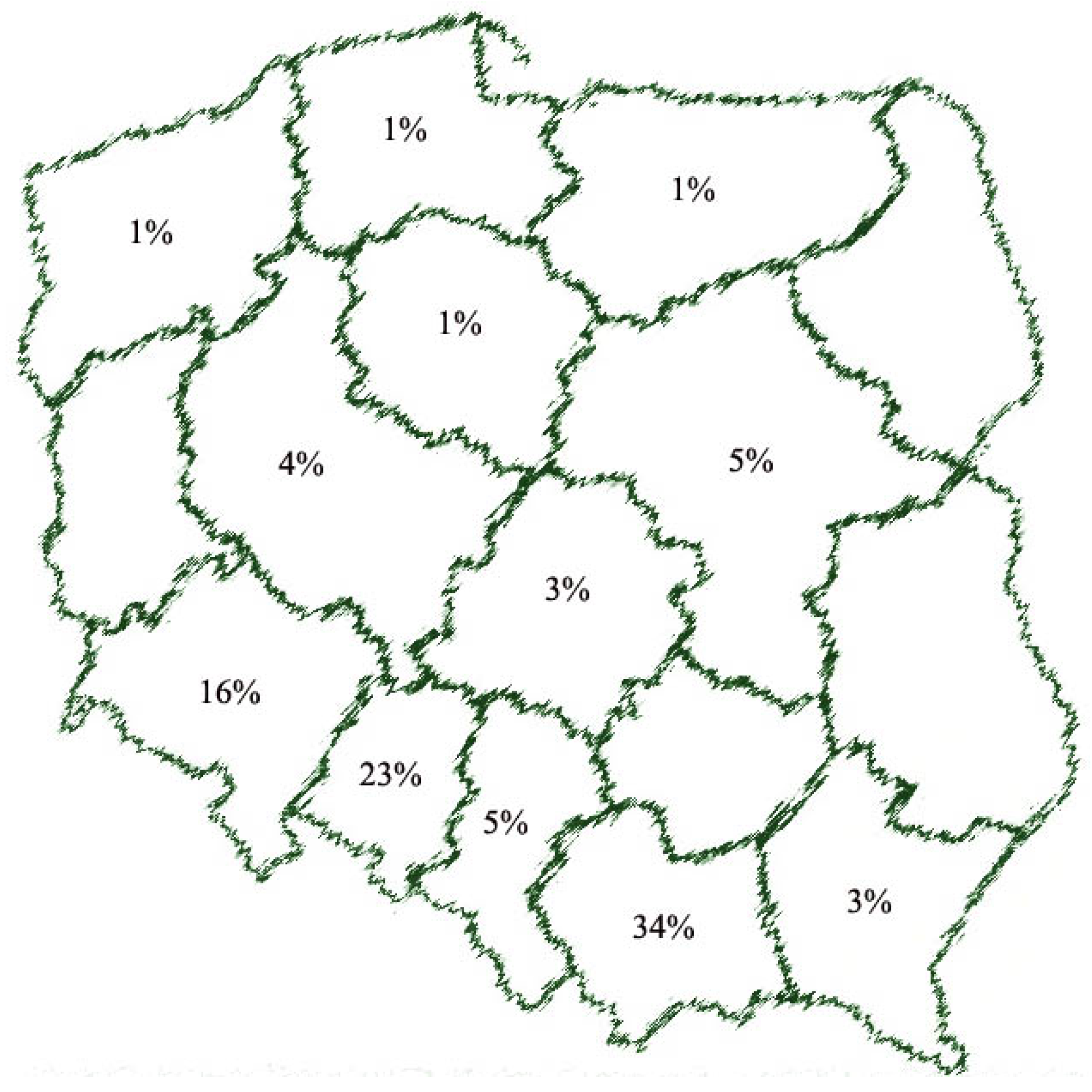



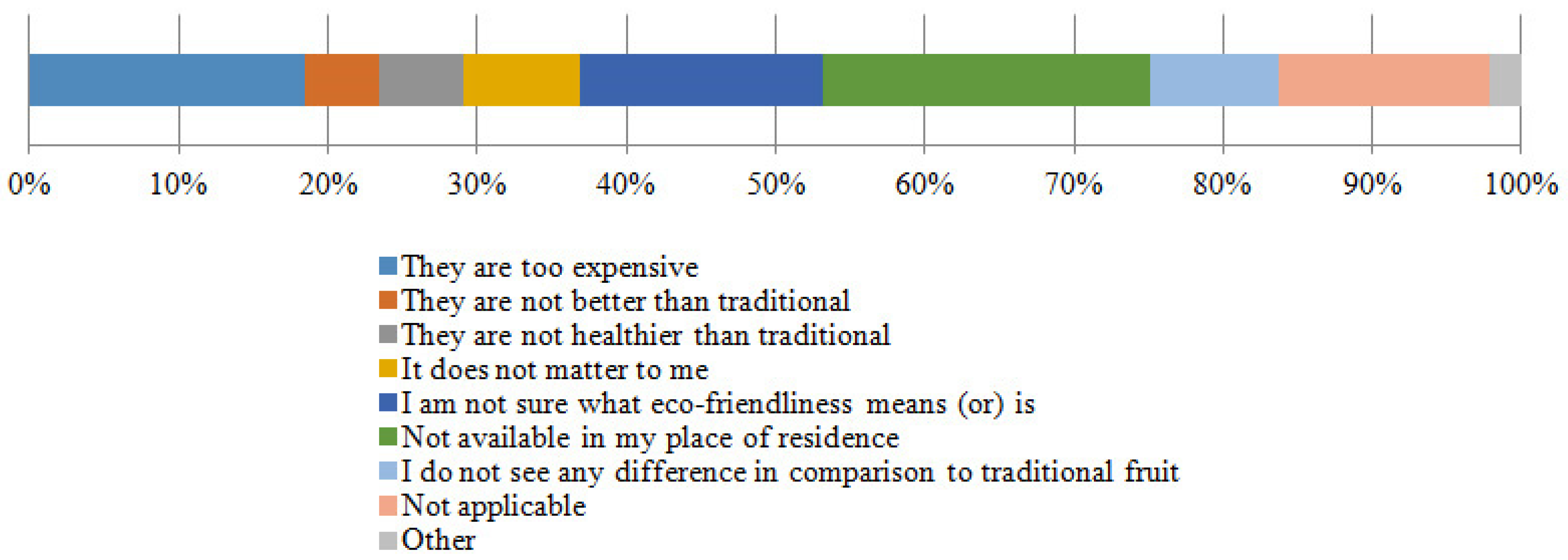
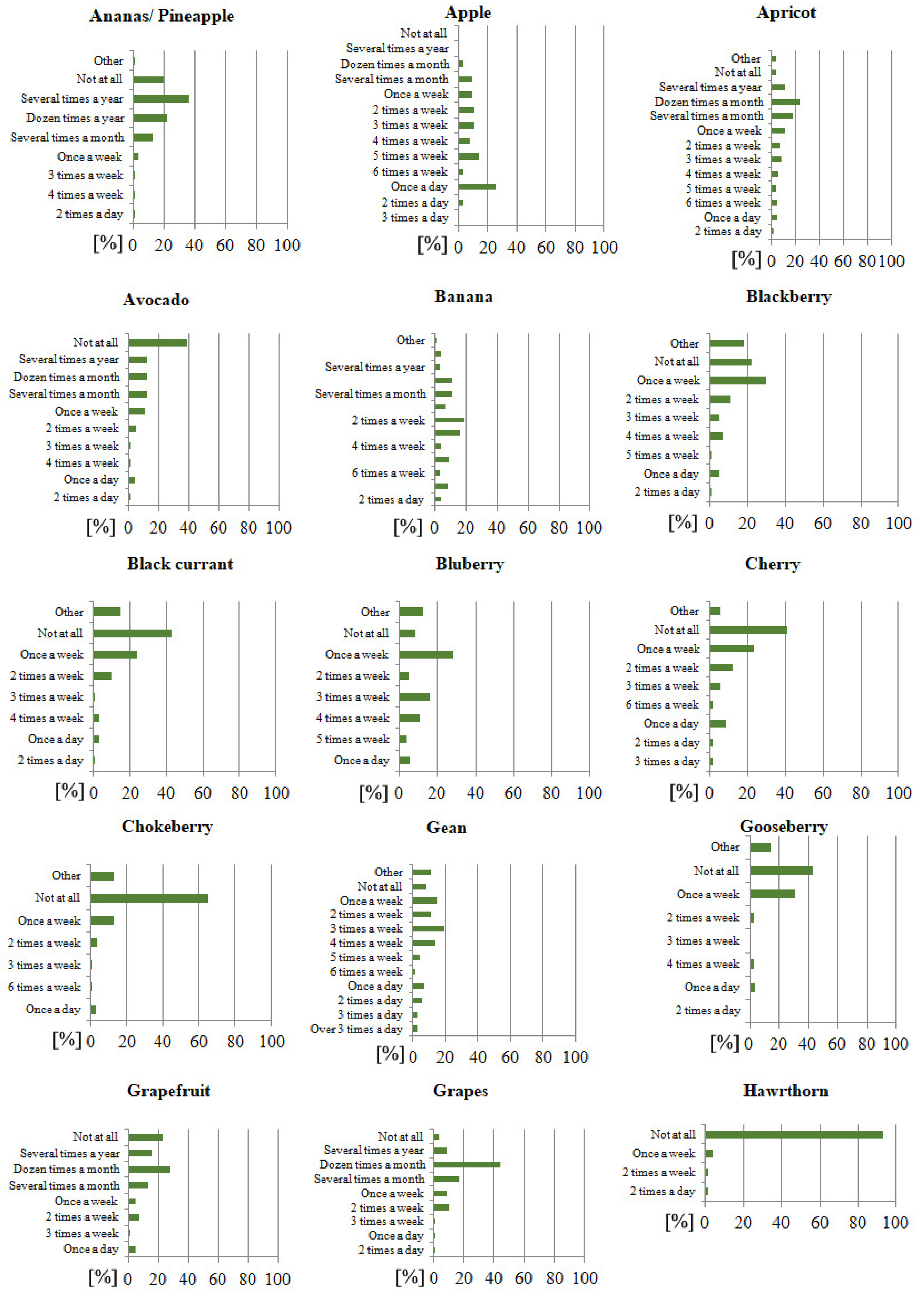
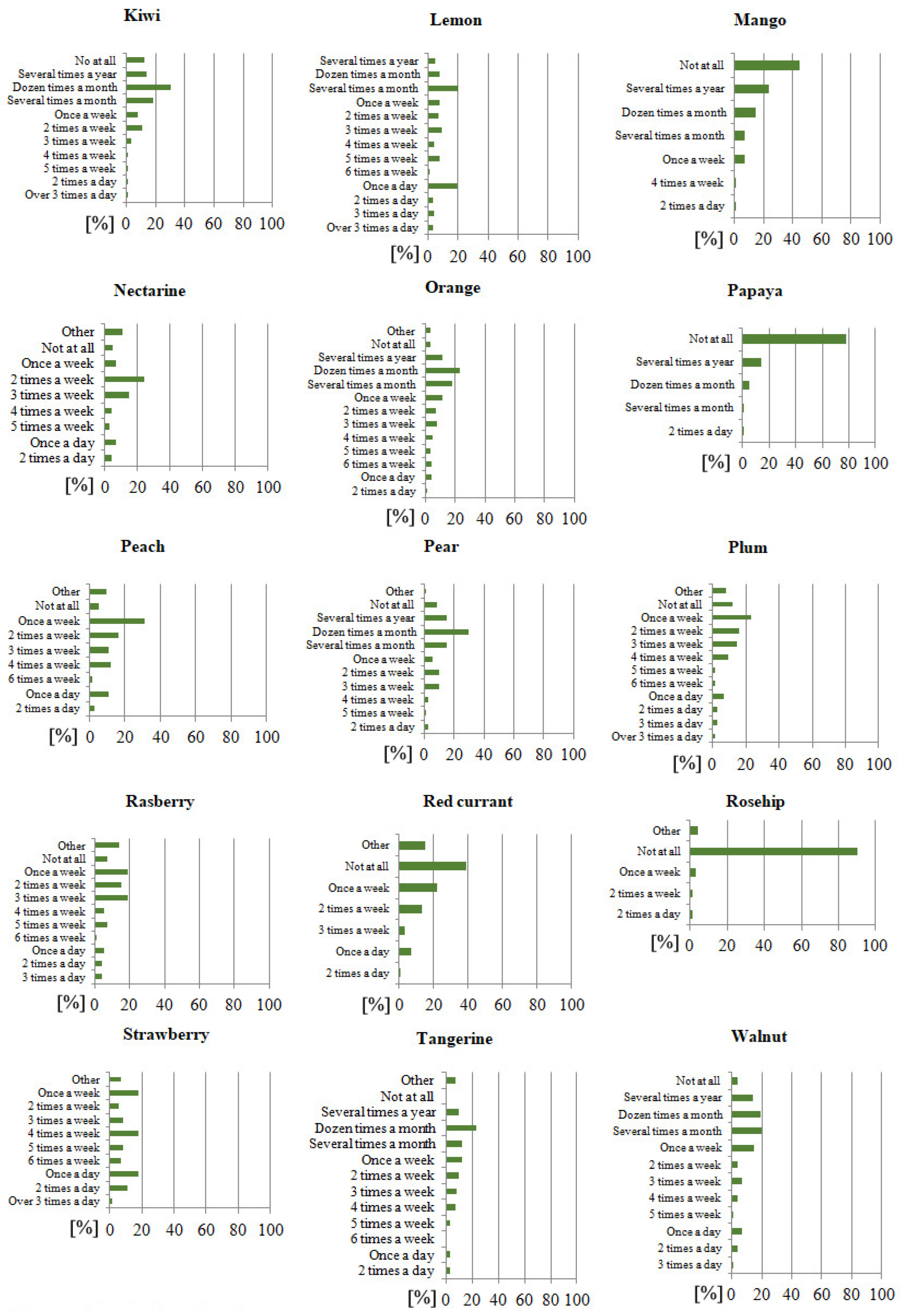

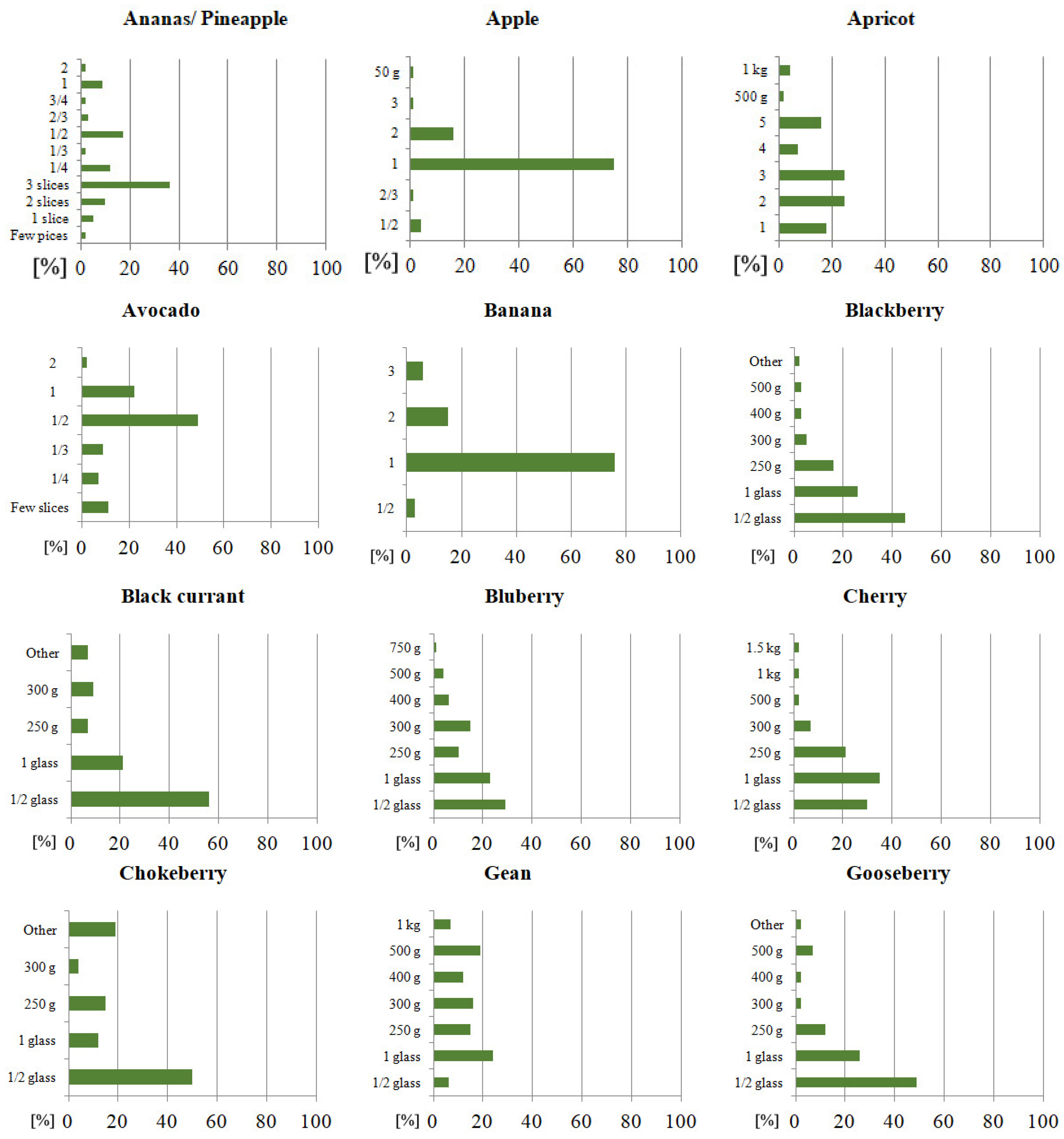
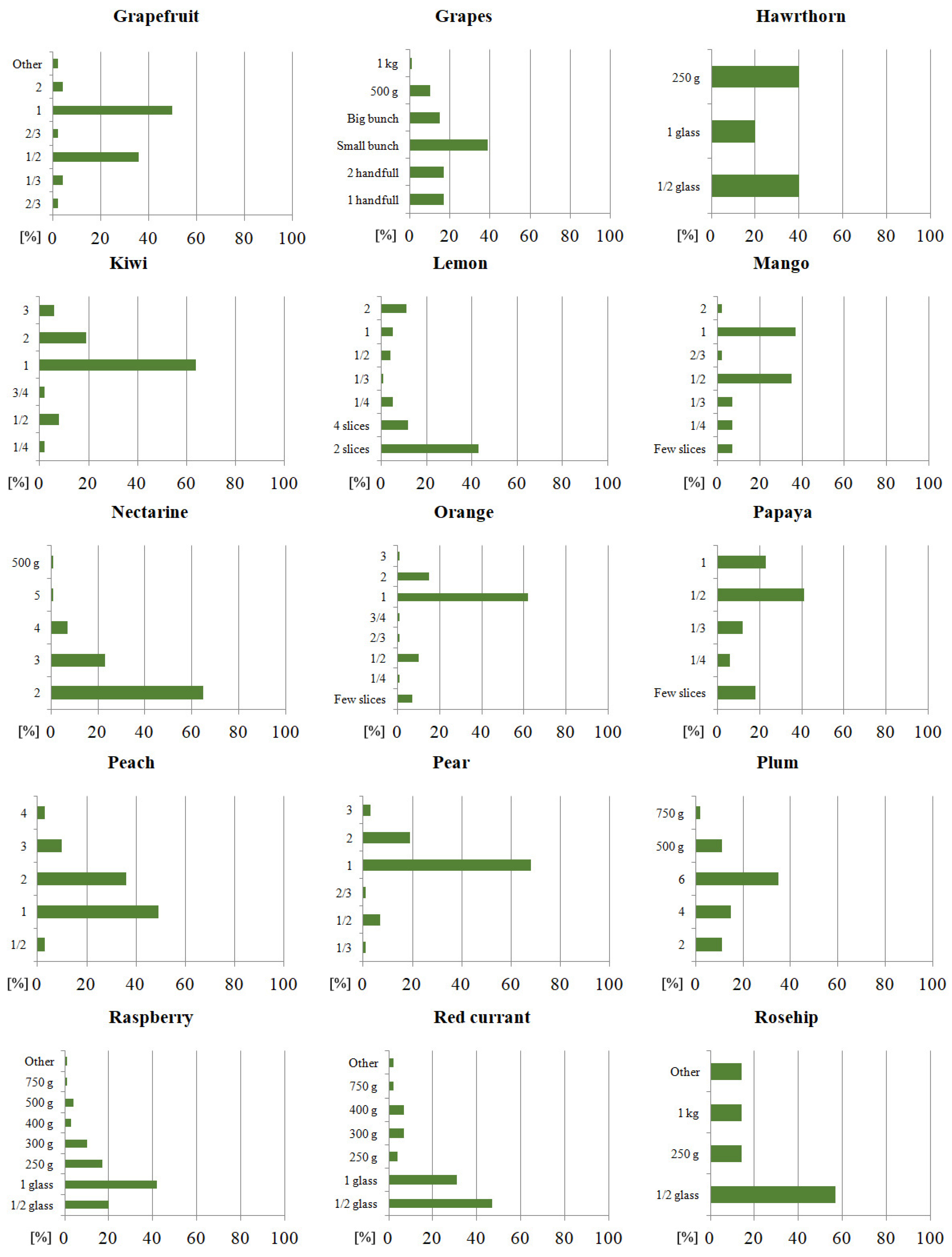
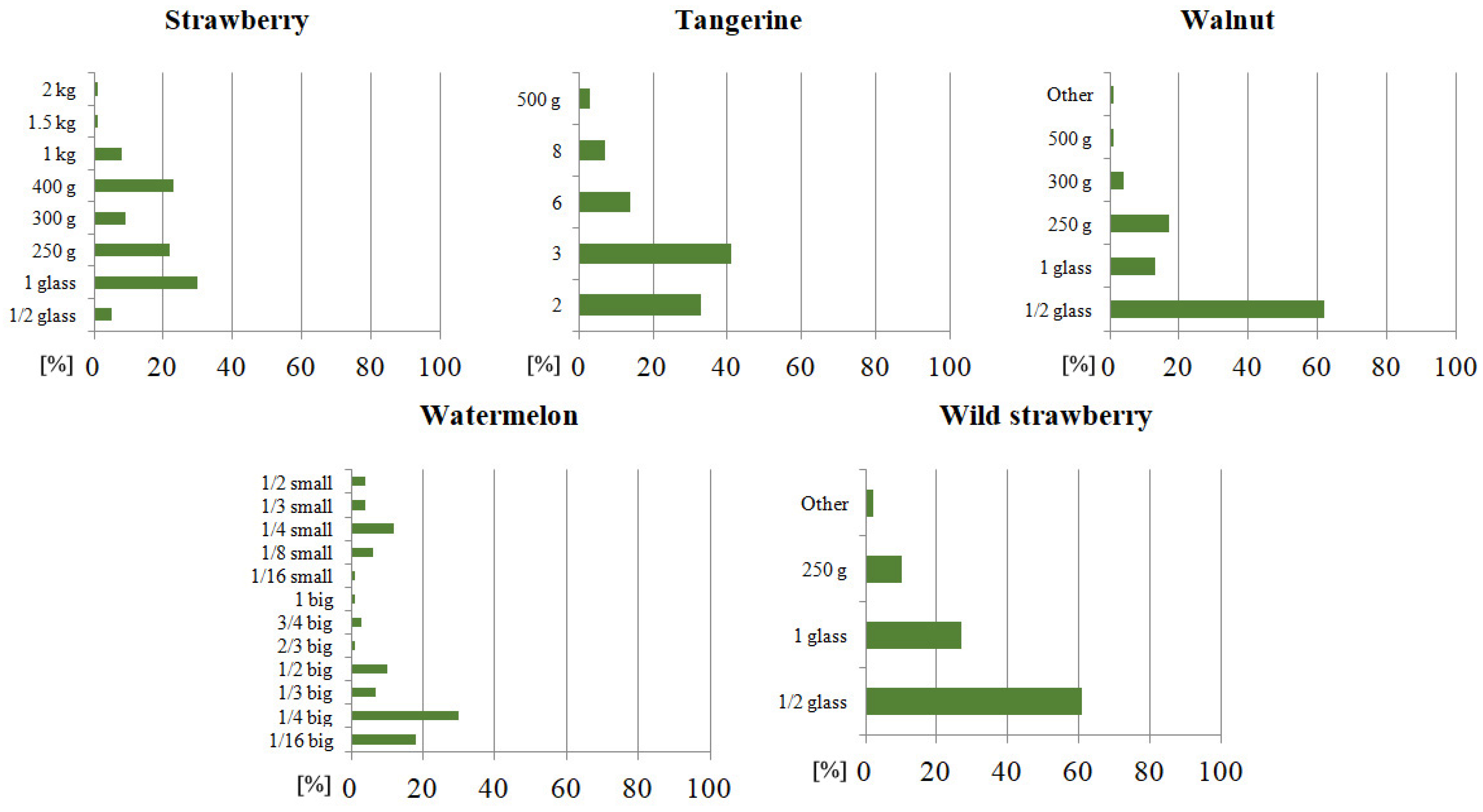
| No. | Common Name | Botanical Name | No. | Common Name | Botanical Name |
|---|---|---|---|---|---|
| 1. | Ananas | Ananas comosus | 17. | Lemon | Citrus limon |
| 2. | Apple | Malus domestica | 18. | Mango | Mangifera indica |
| 3. | Apricot | Prunus armeniaca | 19. | Nectarine | Prunus persica var. nucipersica |
| 4. | Avocado | Persea americana | 20. | Orange | Citrus × sinensis |
| 5. | Banana | Musa × paradisiaca | 21. | Papaya | Carica papaya |
| 6. | Blackberry | Rubus fruticosus | 22. | Peach | Prunus persica |
| 7. | Black currant | Ribes nigrum | 23. | Pear | Pyrus communis |
| 8. | Bluberry | Vaccinium myrtillus | 24. | Plum | Prunus domestica |
| 9. | Cherry | Prunus cerasus | 25. | Raspberry | Rubus idaeus |
| 10. | Chokeberry | Aronia melanocarpa | 26. | Red currant | Ribes rubrum |
| 11. | Gean | Prunus avium | 27. | Rosehip | Rosa canina |
| 12. | Gooseberry | Ribes uva-crispa | 28. | Strawberry | Fragaraia × ananassa Duchesne |
| 13. | Grapefruit | Citrus × paradisi | 29. | Tangerine | Citrus reticulata |
| 14. | Grapes | Vitis vinifera | 30. | Walnut | Juglans regia |
| 15. | Hawthorn | Crataegus oxyacantha | 31. | Watermelon | Citrullus lanatus |
| 16. | Kiwi | Actinidia | 32. | Wild strawberry | Fragaria vesca |
| Demographic Factor | Frequency (n = 74) | Percentage (%) | |
|---|---|---|---|
| Gender | Male | 19 | 26 |
| Female | 55 | 74 | |
| Prefer not to answer | 0 | 0 | |
| Age | 18–20 years | 3 | 2 |
| 21–30 years | 16 | 22 | |
| 31–40 years | 26 | 35 | |
| 41–50 years | 11 | 15 | |
| 51–60 years | 5 | 7 | |
| 61–70 years | 7 | 9 | |
| Over 70 years | 5 | 7 | |
| Refusal to answer | 1 | 1 | |
| Educational level | Secondary education | 5 | 7 |
| Secondary vocational | 3 | 4 | |
| Post-secondary | 7 | 10 | |
| Higher vocational | 3 | 4 | |
| Bachelor degree | 4 | 5 | |
| Master degree | 49 | 67 | |
| Refusal to answer | 3 | 2 | |
| Marital status | Single | 24 | 32 |
| Married/in relation | 41 | 55 | |
| Separation/after divorce | 2 | 3 | |
| Widowed | 4 | 5 | |
| Refusal to answer | 3 | 2 | |
| Region of Poland | Dolnośląskie | 12 | 16 |
| (voivodeship/province) | Kujawsko-pomorskie | 1 | 1 |
| Łódzkie | 2 | 3 | |
| Małopolskie | 25 | 34 | |
| Mazowieckie | 4 | 5 | |
| Opolskie | 17 | 23 | |
| Podkarpackie | 2 | 3 | |
| Pomorskie | 1 | 1 | |
| Śląskie | 4 | 5 | |
| Warmińsko-Mazurskie | 1 | 1 | |
| Wielkopolskie | 3 | 4 | |
| Zachodniopomorskie | 1 | 1 | |
| Refusal to answer | 1 | 1 | |
| Area of residence, number of inhabitants | Countryside agricultural area | 8 | 11 |
| City, up to 20,000 | 1 | 1 | |
| City, 21,000–100,000 | 8 | 11 | |
| City, 101,000–250,000 | 14 | 19 | |
| City, 251,000–500,000 | 5 | 7 | |
| City, 501,000–750,000 | 7 | 9 | |
| City, 751,000–1,000,000 | 19 | 26 | |
| City, over 1,000,000 | 9 | 12 | |
| Refusal to answer | 3 | 4 | |
| Number of people in the household | 1 | 12 | 9 |
| 2 | 30 | 41 | |
| 3 | 13 | 18 | |
| 4 | 11 | 15 | |
| 5 | 5 | 7 | |
| 6 | 1 | 1 | |
| 7 | 1 | 1 | |
| Refusal to answer | 1 | 1 | |
| Indicative net income in PLN [in USD] | Up to PLN 1000 [USD 251.5] | 4 | 5 |
| PLN 1001–3000 [USD 251.7–754.5] | 33 | 45 | |
| PLN 3001–5000 [USD 754.8–1257.6] | 12 | 16 | |
| PLN 5001–7000 [USD 1257.8–1760.6] | 11 | 15 | |
| PLN 7001–9000 [USD 1760.8–2263.6] | 1 | 1 | |
| Over PLN 9000 [USD 2263.6] | 2 | 3 | |
| Refusal to answer | 11 | 15 |
| Observed | Expected | ||||
|---|---|---|---|---|---|
| Gender | Female | Male | Female | Male | p-Value |
| Almost always | 1 | 0 | 0.7 | 0.3 | |
| Often | 6 | 1 | 5.2 | 1.8 | |
| Rarely | 23 | 6 | 21.6 | 7.4 | |
| Almost never | 10 | 4 | 10.4 | 3.6 | |
| Never | 10 | 4 | 10.4 | 3.6 | |
| ? | 5 | 4 | 6.7 | 2.3 | 0.7025 |
| Decision | H0 | ||||
| Observed | Expected | ||||||||||||||||||
|---|---|---|---|---|---|---|---|---|---|---|---|---|---|---|---|---|---|---|---|
| Age | 13–16 | 17–19 | 20–30 | 31–40 | 41–50 | 51–60 | 61–70 | >71 | ? | 13–16 | 17–19 | 20–30 | 31–40 | 41–50 | 51–60 | 61–70 | >71 | ? | p-Value |
| Almost always | 0 | 0 | 0 | 0 | 0 | 0 | 0 | 1 | 0 | 0.0 | 0.0 | 0.2 | 0.4 | 0.1 | 0.1 | 0.1 | 0.1 | 0.0 | |
| Often | 0 | 0 | 0 | 1 | 2 | 0 | 3 | 0 | 1 | 0.1 | 0.2 | 1.5 | 2.5 | 1.0 | 0.5 | 0.7 | 0.5 | 0.1 | |
| Rarely | 0 | 1 | 5 | 13 | 5 | 1 | 4 | 0 | 0 | 0.4 | 0.8 | 6.3 | 10.2 | 4.3 | 2.0 | 2.7 | 2.0 | 0.4 | |
| Almost never | 1 | 0 | 4 | 5 | 0 | 2 | 0 | 2 | 0 | 0.2 | 0.4 | 3.0 | 4.9 | 2.1 | 0.9 | 1.3 | 0.9 | 0.2 | |
| Never | 0 | 0 | 4 | 4 | 3 | 2 | 0 | 1 | 0 | 0.2 | 0.4 | 3.0 | 4.9 | 2.1 | 0.9 | 1.3 | 0.9 | 0.2 | |
| ? | 0 | 1 | 3 | 3 | 1 | 0 | 0 | 1 | 0 | 0.1 | 0.2 | 1.9 | 3.2 | 1.3 | 0.6 | 0.9 | 0.6 | 0.1 | 0.0245 |
| Decision | H1 | ||||||||||||||||||
| Observed | Expected | ||||||||||||||
|---|---|---|---|---|---|---|---|---|---|---|---|---|---|---|---|
| Education Level * | ? | 1 | 2 | 3 | 4 | 5 | 6 | ? | 1 | 2 | 3 | 4 | 5 | 6 | p-Value |
| Almost always | 0 | 0 | 0 | 0 | 0 | 0 | 1 | 0.04 | 0.07 | 0.04 | 0.09 | 0.04 | 0.05 | 0.66 | |
| Often | 0 | 2 | 0 | 1 | 1 | 0 | 3 | 0.28 | 0.47 | 0.28 | 0.66 | 0.28 | 0.38 | 4.64 | |
| Rarely | 0 | 1 | 1 | 3 | 2 | 2 | 18 | 1.09 | 1.82 | 1.09 | 2.55 | 1.09 | 1.46 | 17.88 | |
| Almost never | 0 | 0 | 0 | 0 | 0 | 0 | 13 | 0.53 | 0.88 | 0.53 | 1.23 | 0.53 | 0.70 | 8.61 | |
| Never | 0 | 0 | 0 | 2 | 0 | 1 | 11 | 0.57 | 0.95 | 0.57 | 1.32 | 0.57 | 0.76 | 9.27 | |
| ? | 3 | 2 | 2 | 1 | 0 | 1 | 3 | 0.49 | 0.81 | 0.49 | 1.14 | 0.49 | 0.65 | 7.95 | 0.0413 |
| Decision | H1 | ||||||||||||||
| Observed | Expected | ||||||||||
|---|---|---|---|---|---|---|---|---|---|---|---|
| Marital Status | Single | Married/in Relation | Separation/after Divorce | Widowed | ? | Single | Married/in Relation | Separation/after Divorce | Widowed | ? | p-Value |
| Almost always | 0 | 0 | 0 | 1 | 0 | 0.3 | 0.6 | 0.0 | 0.1 | 0.0 | |
| Often | 2 | 4 | 0 | 1 | 0 | 2.3 | 3.9 | 0.2 | 0.4 | 0.3 | |
| Rarely | 7 | 19 | 0 | 1 | 3 | 9.7 | 16.6 | 0.8 | 1.6 | 1.2 | |
| Almost never | 5 | 8 | 0 | 0 | 0 | 4.2 | 7.2 | 0.4 | 0.7 | 0.5 | |
| Never | 5 | 7 | 1 | 1 | 0 | 4.5 | 7.8 | 0.4 | 0.8 | 0.6 | |
| ? | 5 | 3 | 1 | 0 | 0 | 2.9 | 5.0 | 0.2 | 0.5 | 0.4 | 0.0347 |
| Decision | H1 | ||||||||||
| Observed | Expected | ||||||||||||||||||||||||||
|---|---|---|---|---|---|---|---|---|---|---|---|---|---|---|---|---|---|---|---|---|---|---|---|---|---|---|---|
| Region of Residence * | 1 | 2 | 3 | 4 | 5 | 6 | 7 | 8 | 9 | 10 | 11 | 12 | ? | 1 | 2 | 3 | 4 | 5 | 6 | 7 | 8 | 9 | 10 | 11 | 12 | ? | p-Value |
| Almost always | 0 | 0 | 0 | 1 | 0 | 0 | 0 | 0 | 0 | 0 | 0 | 0 | 0 | 0.16 | 0.01 | 0.03 | 0.34 | 0.05 | 0.23 | 0.03 | 0.01 | 0.05 | 0.01 | 0.04 | 0.01 | 0.01 | |
| Often | 0 | 0 | 0 | 2 | 1 | 3 | 0 | 0 | 0 | 0 | 0 | 0 | 1 | 1.14 | 0.09 | 0.19 | 2.36 | 0.38 | 1.61 | 0.19 | 0.09 | 0.38 | 0.09 | 0.28 | 0.09 | 0.09 | |
| Rarely | 6 | 0 | 2 | 10 | 2 | 4 | 1 | 0 | 1 | 1 | 2 | 0 | 0 | 4.70 | 0.39 | 0.78 | 9.80 | 1.57 | 6.66 | 0.78 | 0.39 | 1.57 | 0.39 | 1.18 | 0.39 | 0.39 | |
| Almost never | 2 | 1 | 0 | 2 | 0 | 5 | 1 | 0 | 1 | 0 | 1 | 1 | 0 | 2.27 | 0.19 | 0.38 | 4.73 | 0.76 | 3.22 | 0.38 | 0.19 | 0.76 | 0.19 | 0.57 | 0.19 | 0.19 | |
| Never | 3 | 0 | 0 | 5 | 0 | 4 | 0 | 0 | 2 | 0 | 0 | 0 | 0 | 2.27 | 0.19 | 0.38 | 4.73 | 0.76 | 3.22 | 0.38 | 0.19 | 0.76 | 0.19 | 0.57 | 0.19 | 0.19 | |
| ? | 1 | 0 | 0 | 5 | 1 | 1 | 0 | 1 | 0 | 0 | 0 | 0 | 0 | 1.46 | 0.12 | 0.24 | 3.04 | 0.49 | 2.07 | 0.24 | 0.12 | 0.49 | 0.12 | 0.36 | 0.12 | 0.12 | 0.7864 |
| Decision | H0 | ||||||||||||||||||||||||||
| Observed | Expected | ||||||||||||||||||
|---|---|---|---|---|---|---|---|---|---|---|---|---|---|---|---|---|---|---|---|
| Area of Residence * | 1 | 2 | 3 | 4 | 5 | 6 | 7 | 8 | ? | 1 | 2 | 3 | 4 | 5 | 6 | 7 | 8 | ? | p-Value |
| Almost always | 0 | 0 | 0 | 0 | 0 | 0 | 1 | 0 | 0 | 0.11 | 0.01 | 0.11 | 0.19 | 0.07 | 0.09 | 0.26 | 0.12 | 0.04 | |
| Often | 0 | 0 | 2 | 2 | 0 | 0 | 3 | 0 | 0 | 0.76 | 0.09 | 0.76 | 1.32 | 0.47 | 0.66 | 1.80 | 0.85 | 0.28 | |
| Rarely | 5 | 1 | 3 | 4 | 1 | 1 | 7 | 5 | 2 | 3.14 | 0.39 | 3.14 | 5.49 | 1.96 | 2.74 | 7.45 | 3.53 | 1.18 | |
| Almost never | 2 | 0 | 1 | 4 | 3 | 0 | 3 | 1 | 0 | 1.51 | 0.19 | 1.51 | 2.65 | 0.95 | 1.32 | 3.59 | 1.70 | 0.57 | |
| Never | 1 | 0 | 2 | 3 | 1 | 3 | 2 | 2 | 0 | 1.51 | 0.19 | 1.51 | 2.65 | 0.95 | 1.32 | 3.59 | 1.70 | 0.57 | |
| ? | 0 | 0 | 0 | 1 | 0 | 3 | 3 | 1 | 1 | 0.97 | 0.12 | 0.97 | 1.70 | 0.61 | 0.85 | 2.31 | 1.09 | 0.36 | 0.6446 |
| Decision | H0 | ||||||||||||||||||
| Observed | Expected | ||||||||||||||||
|---|---|---|---|---|---|---|---|---|---|---|---|---|---|---|---|---|---|
| Number of People in the Houshold | 1 | 2 | 3 | 4 | 5 | 6 | 7 | ? | 1 | 2 | 3 | 4 | 5 | 6 | 7 | ? | p-Value |
| Almost always | 1 | 0 | 0 | 0 | 0 | 0 | 0 | 0 | 0.18 | 0.43 | 0.22 | 0.20 | 0.14 | 0.09 | 0.11 | 0.01 | |
| Often | 3 | 2 | 1 | 1 | 0 | 0 | 0 | 0 | 1.23 | 3.03 | 1.51 | 1.42 | 0.95 | 0.66 | 0.76 | 0.09 | |
| Rarely | 2 | 10 | 5 | 7 | 3 | 0 | 1 | 1 | 5.09 | 12.54 | 6.27 | 5.88 | 3.92 | 2.74 | 3.14 | 0.39 | |
| Almost never | 2 | 7 | 3 | 1 | 0 | 1 | 0 | 0 | 2.46 | 6.05 | 3.03 | 2.84 | 1.89 | 1.32 | 1.51 | 0.19 | |
| Never | 2 | 8 | 3 | 0 | 1 | 0 | 0 | 0 | 2.46 | 6.05 | 3.03 | 2.84 | 1.89 | 1.32 | 1.51 | 0.19 | |
| ? | 2 | 3 | 1 | 2 | 1 | 0 | 0 | 0 | 1.58 | 3.89 | 1.95 | 1.82 | 1.22 | 0.85 | 0.97 | 0.12 | 0.5250 |
| Decision | H0 | ||||||||||||||||
| Observed | Expected | ||||||||||||||
|---|---|---|---|---|---|---|---|---|---|---|---|---|---|---|---|
| Net Income * | 1 | 2 | 3 | 4 | 5 | 6 | ? | 1 | 2 | 3 | 4 | 5 | 6 | ? | p-Value |
| Almost always | 0 | 1 | 0 | 0 | 0 | 0 | 0 | 0.05 | 0.45 | 0.16 | 0.15 | 0.01 | 0.03 | 0.15 | |
| Often | 0 | 2 | 1 | 3 | 0 | 1 | 0 | 0.38 | 3.12 | 1.14 | 1.04 | 0.09 | 0.19 | 1.04 | |
| Rarely | 2 | 12 | 4 | 4 | 0 | 1 | 6 | 1.57 | 12.93 | 4.70 | 4.31 | 0.39 | 0.78 | 4.31 | |
| Almost never | 0 | 7 | 3 | 3 | 0 | 0 | 1 | 0.76 | 6.24 | 2.27 | 2.08 | 0.19 | 0.38 | 2.08 | |
| Never | 2 | 6 | 3 | 1 | 0 | 0 | 2 | 0.76 | 6.24 | 2.27 | 2.08 | 0.19 | 0.38 | 2.08 | |
| ? | 0 | 5 | 1 | 0 | 1 | 0 | 2 | 0.49 | 4.01 | 1.46 | 1.34 | 0.12 | 0.24 | 1.34 | 0.6269 |
| Decision | H0 | ||||||||||||||
Disclaimer/Publisher’s Note: The statements, opinions and data contained in all publications are solely those of the individual author(s) and contributor(s) and not of MDPI and/or the editor(s). MDPI and/or the editor(s) disclaim responsibility for any injury to people or property resulting from any ideas, methods, instructions or products referred to in the content. |
© 2023 by the authors. Licensee MDPI, Basel, Switzerland. This article is an open access article distributed under the terms and conditions of the Creative Commons Attribution (CC BY) license (https://creativecommons.org/licenses/by/4.0/).
Share and Cite
Gruszecka-Kosowska, A.; Mazur-Włodarczyk, K.; Wódkowska, A. Native vs. Unique Fruit Popularity: Exploring the Sustainable Fruit Consumption in Poland—Research Report. Sustainability 2023, 15, 10953. https://doi.org/10.3390/su151410953
Gruszecka-Kosowska A, Mazur-Włodarczyk K, Wódkowska A. Native vs. Unique Fruit Popularity: Exploring the Sustainable Fruit Consumption in Poland—Research Report. Sustainability. 2023; 15(14):10953. https://doi.org/10.3390/su151410953
Chicago/Turabian StyleGruszecka-Kosowska, Agnieszka, Katarzyna Mazur-Włodarczyk, and Agata Wódkowska. 2023. "Native vs. Unique Fruit Popularity: Exploring the Sustainable Fruit Consumption in Poland—Research Report" Sustainability 15, no. 14: 10953. https://doi.org/10.3390/su151410953
APA StyleGruszecka-Kosowska, A., Mazur-Włodarczyk, K., & Wódkowska, A. (2023). Native vs. Unique Fruit Popularity: Exploring the Sustainable Fruit Consumption in Poland—Research Report. Sustainability, 15(14), 10953. https://doi.org/10.3390/su151410953








